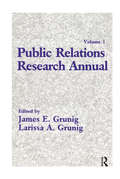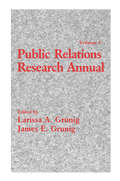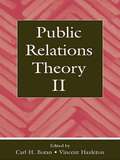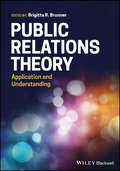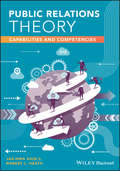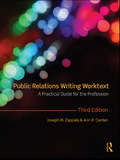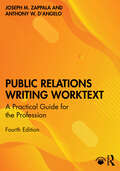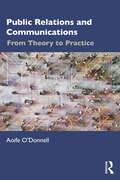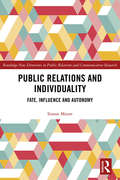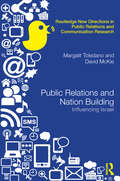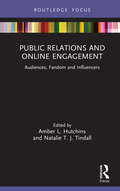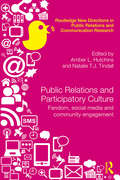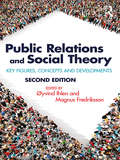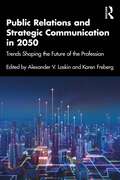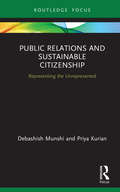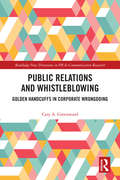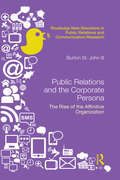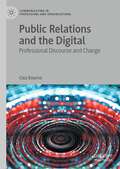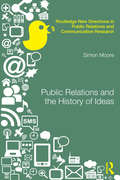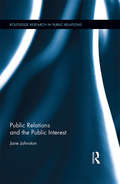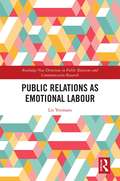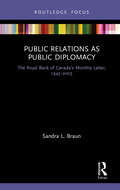- Table View
- List View
Public Relations Research Annual: Volume 1
by James E. Grunig Larissa A. GrunigThe first volume of this series features reviews of research programs, original research reports, and social scientific, historical, critical and humanistic methodologies.
Public Relations Research Annual: Volume 3
by James E. Grunig Larissa A. GrunigPublished in book form, this is a scholarly periodical of academic research in public relations, containing refereed reviews and reports of original studies. It follows the current trend toward more solidly grounded, theoretical research in a field that has only begun to mature. The studies and reviews presented represent the most contemporary thought and investigation brought to bear on this subject. Many relevant topics are discussed, including communication roles, women's issues in the feminization of the field, the concepts of symmetry and game theory, and finally, publics -- dealing with roles, risk takers, and how audiences receive, process, and retain messages on public policy issues.
Public Relations Theory II (Routledge Communication Series)
by Carl H. Botan Vincent HazletonThe public relations landscape has changed dramatically from what it was in 1989, when the original Public Relations Theory volume was published. Reflecting the substantial shifts in the intervening years, Public Relations Theory II, while related to the first volume, is more a new work than a revision. Editors Carl H. Botan and Vincent Hazleton have brought together key theorists and scholars in public relations to articulate the current state of public relations theory, chronicling the ongoing evolution of public relations as a field of study. The contributors to this volume represent the key figures in the discipline, and their chapters articulate the significant advances in public relations theory and research.Working from the position that public relations is a theoretically grounded and research based discipline with the potential to bring numerous areas of applied communication together, Botan and Hazleton have developed this volume to open up the public relations field to a broad variety of theories. Organized into two major sections--Foundations, and Tools for Tomorrow--the volume presents four types of chapters: discussions addressing how public relations should be understood and practiced; examinations of theories from other areas applied to public relations; explorations of theories about a specific area of public relations practice; and considerations of public relations theories and research that have not been given sufficient attention in the past or that hold particular promise for the future of public relations. It serves as a thorough overview of the current state of theory in public relations scholarship. Like its predecessor, Public Relations Theory II will be influential in the future development of public relations theory. Taken as a whole, the chapters in this book will help readers develop their own sense of direction for public relations theory. Public Relations Theory II is an essential addition to the library of every public relations scholar, and is appropriate for use in advanced public relations theory coursework as well as for study and reference.
Public Relations Theory III: In the Age of Publics (Routledge Communication Series)
by Carl H. Botan Erich J. SommerfeldtThis important book chronicles, responds to, and advances the leading theories in the public relations discipline. Taking up the work begun by the books Public Relations Theory and Public Relations Theory II, this volume offers completely original material reflecting public relations as practiced today. It features contributions by leading public relations researchers from around the world who write about new developments in the field. Important subjects include: a turn to more humanistic, social, dialogic, and cocreational perspectives on public relations; changes in the capacity and use of new information technologies; a greater emphasis on non-Western international and intercultural public relations that considers an increasingly politically polarized culture; and issues of ethics that look beyond how clients and the traditional mass media are treated and into much broader questions of voice, agency, race, identity, and the economic and political status of publics. This book is a touchstone for advanced undergraduate and graduate courses in public relations theory and a key reference for researchers.
Public Relations Theory: Application and Understanding
by Brigitta R. BrunnerThe comprehensive guide to applied PR theory in the 21st century Public Relations Theory explores the central principles and theoretical components of public relations and their practical applications in actual situations. This informative text helps readers to understand the concepts, approaches, and perspectives of PR theory and learn development methods, implementation strategies, management techniques, and more. Chapters written by recognized experts on each topic provide readers with knowledge on how, when, and why appropriate theories are applied. Focusing on how organizations and individuals integrate theory in a public relations framework, each chapter explains one function, explores its potential challenges and opportunities, provides an example of the function in practice, and offers discussion questions and additional reading suggestions. Unique in structure, this text arranges chapters by function, rather than theory, allowing readers to see how multiple theories can be applied to each public relations function and how theories can be used in different professional settings. Comprehensive treatment of topics including social and emerging media, globalization, public diplomacy, corporate and investor relations, and others ensures relevant and timely coverage of contemporary PR issues. Demonstrates how public relations theory is applied in real-world practice Illustrates how successfully applied public relations theories lead to positive outcomes Discusses the relevance of public relations with accessible and engaging language Offers multiple perspectives from leading international public relations scholars Includes pedagogical tools including chapter discussion questions, practical examples, tables, and suggested reading lists Public Relations Theory: Application and Understanding is suitable for instructors and graduate and advanced undergraduate students in courses on public relations theory, as well as practitioners seeking further knowledge on the most current developments in the field.
Public Relations Theory: Capabilities and Competencies
by Robert L. Heath Jae-Hwa ShinExplore a wide range of theoretical frameworks and themes for public relations in this comprehensive and authoritative work Public Relations Theory: Capabilities and Competencies is a comprehensive overview of the major theoretical perspectives in public relations, considering the evolution, diversification and merger of approaches that have been spurred by rapid changes in society, cultural boundaries, technology, and media environments. Authors Jae-Hwa Shin and Robert Heath explain both organizational and social theories of public relations, including cases and challenges to help students bring theory and research to bear on solving the daily challenges of public relations practice. Rather than advocate in favor of a particular theoretical view or position, Public Relations Theory: Capabilities and Competencies covers a broad range of theoretical perspectives and themes in public relations, including: An examination of excellence theory, contingency theory, rhetorical theory, and critical theory as these perspectives apply to public relations Issues management, crisis management, risk management and conflict management with respect to public relations Combining theory and practice for conceptualization and strategic execution of robust public relations programs and campaigns The importance of public relations ethics to serve the public good How to define “the public” or “relationships” in the field of public relations The book closes with discussion of emerging topics and the recent transformation of public relations theory to take diversity, technology, and global identity into account and offers insight into future direction. This book is perfect for upper level undergraduate and graduate students of public relations in journalism and communication. It will also be useful for public relations practitioners who hope to improve their understanding of the theoretical background and principles of their work and serve as an excellent reference for doctoral students and researchers in the area.
Public Relations Writing Worktext: A Practical Guide for the Profession
by Ann R. Carden Joseph M. ZappalaPublic Relations Writing Worktext provides the fundamental knowledge and the basic preparation required for the professional practice of public relations writing. This textbook introduces readers to public relations and writing, providing an overview of the four-step public relations process in addition to defining and detailing the writing activities involved. It presents in-depth information on the writing formats and approaches used in implementing strategic public relations plans, and offers instruction for developing all types of writing assignments, starting with memos, proposals, and news releases, and moving on to the more complex tasks of advocacy writing, newsletters, crisis planning, and online communication. Examples accompany the discussions, providing guidance and structure for the varied writing activities. Retaining the approach of the second edition, this text incorporates numerous changes and updates, making it suitable for use as a primary course text. Updates include: increased focus on writing for the web, blogs, and electronic media, including information on writing social media releases and a new chapter entitled "New and Social Media" a new planning outline to help writers develop more effective messages expanded checklists for writers to reference when working on assignments additional examples of effective public relations writing by leading companies in a variety of organizational settings, including Mattel, UPS, Burger King, Sara Lee, Xerox, Frito-Lay, and many more new assignments based on topics, issues and problems that public relations professionals in all sectors face today restructured content for improved writing flow and consistency full instructor manual available at www.routledge.com/textbooks/zappala Authors Joseph M. Zappala and Ann R. Carden offer a clear and engaging introduction to the writing activities involved in public relations practice, resulting in a valuable resource for professionals as well as a practical classroom text for students planning careers in public relations.
Public Relations Writing Worktext: A Practical Guide for the Profession
by Joseph M. Zappala Anthony W. D’AngeloWith a concise approach that engages students and practitioners, this thoroughly updated fourth edition provides the fundamental knowledge and basic skill preparation required for the professional practice of public relations writing.Building on the strengths of previous editions, this edition focuses more closely on PR writing as a strategic function and on planning and content strategy design. With practical advice from PR professionals, it covers everything from day-to-day business communications and media tools to writing for social media and crisis situations.This fourth edition incorporates a number of changes and updates, including: New chapters on Social Media and Writing for Key Publics and new content on the use of generative AI and its impact on PR writing. Expanded chapters on Writing for Digital Communications and on Publications, Presentations, and Speeches. New guest columns from PR professionals on topics including writing and pitching the media, inclusive writing, speech writing. and measuring writing/content impact. New cases and assignments based on topics, issues, and problems that public relations professionals face today. The text is suitable for undergraduate and graduate students in a public relations writing course preparing for entry-level public relations and communications roles, as well as a useful reference for early-career practitioners.Online resources also accompany the book: teaching materials, test banks, and reference sources. Please visit www.routledge.com/9780367860028.
Public Relations and Communications: From Theory to Practice
by Aoife O'DonnellThis book provides an introduction to public relations (PR) that employs pedagogical experiential learning models to assist students in developing the skills and competencies required by the PR industry. The book takes the reader on a journey from the theory and origins of PR, through to the structure of the PR profession and the more practical elements of how PR is practiced today. It devotes attention to the common competencies necessary for success as a communications professional, such as communication skills, critical thinking skills and business acumen, while giving due focus to the rapidly evolving new technologies and media that impact how organisations communicate. Featuring example cases from around the world, each chapter includes discussion topics and scenario-based questionnaires to encourage learning and assist students in developing key competencies. This book is ideal for undergraduate PR modules, particularly those with experiential and/or blended learning pedagogical approaches. It will also be useful to those in business seeking to gain a deeper understanding of communications. Situational Judgement Tests and sample press releases, presented as online resources, also accompany the book. Please visit www.routledge.com/9781032170435.
Public Relations and Communications: From Theory to Practice
by Aoife O'DonnellThis book provides an introduction to public relations (PR) that employs pedagogical experiential learning models to assist students in developing the skills and competencies required by the PR industry.The book takes the reader on a journey from the theory and origins of PR, through to the structure of the PR profession and the more practical elements of how PR is practiced today. It devotes attention to the common competencies necessary for success as a communications professional, such as communication skills, critical thinking skills and business acumen, while giving due focus to the rapidly evolving new technologies and media that impact how organisations communicate. Featuring example cases from around the world, each chapter includes discussion topics and scenario-based questionnaires to encourage learning and assist students in developing key competencies.This book is ideal for undergraduate PR modules, particularly those with experiential and/or blended learning pedagogical approaches. It will also be useful to those in business seeking to gain a deeper understanding of communications.Situational Judgement Tests and sample press releases, presented as online resources, also accompany the book. Please visit www.routledge.com/9781032170435.
Public Relations and Individuality: Fate, Influence and Autonomy (Routledge New Directions In Public Relations And Communication Research Ser.)
by Simon MooreOur individuality is partly shaped by encounters with the external world so it is inconceivable that we are unaffected by the planned management of public communications which manages much of our external experience. Exploring one of the most important mediators between organizations and individual encounters – public relations (PR) – is long overdue. By developing new ways to create and connect with us as members of particular target audiences, has it changed our interior existence by altering perceptions of the world outside ourselves? PR’s massive impact on groups, society or organizations is rightly explored, but its immense influence on our individuality is neglected. In an age where new media makes deepening connections to individuals, the relationship of PR to individuality is one of the field’s most profoundly important issues. This provocative book will assist scholars and advanced students in PR and communication research to develop a clear, structured, disciplined understanding of this phenomenon and its implications.
Public Relations and Nation Building: Influencing Israel (Routledge New Directions in PR & Communication Research)
by David McKie Margalit ToledanoAll public relations emerges from particular environments, but the specific conditions of Israel offer an exceptional study of the accelerators and inhibitors of professional development in the history of a nation. Documenting and analyzing the contribution of one profession to building one specific nation, this book tells the previously-untold story of Israeli public relations practitioners. It illustrates their often-unseen, often-unacknowledged and often-strategic shaping of the events, narratives and symbols of Israel over time and their promotion of Israel to the world. It links the profession’s genesis – including the role of the Diaspora and early Zionist activists – to today’s private and public sector professionals by identifying their roots in Israel’s cultural, economic, media, political, and social systems. It reveals how professional communicators and leaders nurtured and valued collectivism, high consensus, solidarity, and unity over democracy and free speech. It investigates such key underpinning concepts as Hasbara and criticizes non-democratic and sometimes unethical propaganda practices. It highlights unprecedented fundraising and lobbying campaigns that forged Israeli identity internally and internationally. In situating Israeli ideas on democracy in the context of contemporary public relations theory, Public Relations and Nation Building seeks to point ways forward for that theory, for Israel and for the public relations of many other nations.
Public Relations and Online Engagement: Audiences, Fandom and Influencers (Routledge Insights in Public Relations Research)
by Amber L. Hutchins; Natalie T. J. TindallAs media continues to evolve, social media has become even more integral to public relations activities, presenting new opportunities and challenges for practitioners. Relationships between publics and organizations continue to be first and foremost, but the process and possibilities for mutually beneficial relationships are being rewritten in situ. This volume aims to explore and understand highly engaged publics in a variety of social media contexts and across networks. The hope is the expansion and extension of public relations theories and models in this book helps move the discipline forward to keep up with the practice and the media environment. Contributors analyzed a range of organizations and industries, including corporate, entertainment, government, and political movements, to consider how public relations practitioners can facilitate ethical and effective communication between parties. A consistent thread was the need for organizations and practitioners to better understand the diverse backgrounds of publics, including age, ethnicity, gender, and sexual orientation, beyond surface-level demographic stereotypes and assumptions. This book will be of interest to researchers, academics, and students in the field of public relations and communication, especially those with a particular interest in online engagement and social media as a PR tool.
Public Relations and Participatory Culture: Fandom, Social Media and Community Engagement (Routledge New Directions in PR & Communication Research)
by Amber Hutchins Natalie T.J. TindallWhile public relations practitioners have long focused on the relationship between organizations and their stakeholders, there has never been a time when that relationship was so dominated by public participation. The new model of multiple messages originating from multiple publics at varying levels of engagement is widely acknowledged, but not widely explored in scholarly texts. The established model of one-way communication and message control no longer exists. Social media and an increasingly participatory culture means that fans are taking a more active role in the production and co-creation of messages, communication, and meaning. These fans have significant power in the relationship dynamic between the message, the communicator, and the larger audience, yet they have not been defined using current theory and discourse. Our existing conceptions fail to identify these active and engaged publics, let alone understand virtual communities who are highly motivated to communicate with organizations and brands. This innovative and original research collection attempts to address this deficit by exploring these interactive, engaged publics, and open up the complexities of establishing and maintaining relationships in fan-created communities.
Public Relations and Social Theory: Key Figures, Concepts and Developments (Routledge Communication Series)
by Øyvind Ihlen Magnus FredrikssonPublic Relations and Social Theory: Key Figures, Concepts and Developments broadens the theoretical scope of public relations studies by applying the work of a group of prominent social theorists to make sense of the practice. The volume focuses on the work of key social theorists, including Max Weber, Karl Marx, John Dewey, Jürgen Habermas, Niklas Luhmann, Michel Foucault, Ulrich Beck, Pierre Bourdieu, Anthony Giddens, Robert Putnam, Erving Goffman, Peter L. Berger, Gayatri Chakravorty Spivak, Bruno Latour, Dorothy Smith, Zygmunt Bauman, Harrison White, John W. Meyer, Luc Boltanski and Chantal Mouffe. Each chapter is devoted to an individual theorist, providing an overview of that theorist’s key concepts and contributions, and exploring how these can be applied to public relations as a practice. Each chapter also includes a box giving a short and concise presentation of the theorist, along with recommendation of key works and secondary literature.
Public Relations and Strategic Communication in 2050: Trends Shaping the Future of the Profession
by Alexander V. Laskin Karen FrebergTaking stock of the technological, political, economic, and social trends that exist today, this book extends the discussion to analyze and predict how these trends will affect the public relations and strategic communication industry of the future.This book is divided into two sections, the first addressing such key topics as artificial intelligence (AI), big data, political polarization, and misinformation, the second looking at key facets of the profession, such as media relations, crisis communication, and measurement and evaluation. Leading researchers in the discipline share their analysis of these topics while also providing theoretically based and practically relevant insights on how the industry must evolve to keep up with, and perhaps anticipate, changes in culture, society, and technology.This book will be of interest to scholars, industry professionals, and advanced undergraduate and graduate students in public relations and strategic communication.
Public Relations and Sustainable Citizenship: Representing the Unrepresented (Routledge Insights in Public Relations Research)
by Debashish Munshi Priya KurianThis book examines how public relations might re-imagine itself as an instrument of "sustainable citizenship" by exploring alternative models of representing and building relationships with and among marginalised publics that disrupt the standard discourses of public relations. It argues that public relations needs to situate itself in the larger context of citizenship, the values and ethics that inform it and the attitudes and behaviours that characterize it. Interlacing critical public relations with a theoretical fabric woven with strands of postcolonial histories, indigenous studies, feminist studies, and political theory, the book brings out the often-unseen processes of relationship building that nurtures solidarity among historically marginalized publics. The book is illustrated with global cases of public relations as sustainable citizenship in action across three core elements of the earth – air, water, and land. In each of the cases, readers can see how resistance movements, not necessarily aligned with any specific organization or interest group, are seeking to change the status quo of a world increasingly defined by exploitation, overconsumption, sectarianism, and faux nationalism. This challenging book will be of interest to students and scholars of not only public relations but also the broader social and management sciences who are interested in issues of environmental and social justice.
Public Relations and Whistleblowing: Golden Handcuffs in Corporate Wrongdoing (Routledge New Directions in PR & Communication Research)
by Cary A. GreenwoodThere is a growing interest in corporate whistleblowing, but no comprehensive research has yet focused on public relations practice. Drawing on extensive research on Fortune 1000 and Wilshire 5000 corporations, this book reveals executives’ attitudes and relationships toward their organizations and their impact on whistleblowing. Perhaps unsurprisingly, it reveals that wrongdoing in corporations and the privileges of power coexist. Top-ranking public relations executives, who are mostly white and male, are more likely to be aware of wrongdoing but no more likely to blow the whistle, fundamentally due to their positive relationship with their employers. Using the new lens of evolutionary theory, this study explains whistleblowing, retaliation, and relationships, and in the light of the connection between whistleblowing behavior and executives’ attitudes, it proposes a new theory of the phenomenon of Golden Handcuffs. As public attitudes to corporations, corporate social responsibility (CSR), and transparency harden, these findings have serious implications for companies globally. Researchers, scholars, and advanced students in public relations, organizational communication, corporate communication, strategic communication, corporate reputation, and CSR will find this book full of revealing insights.
Public Relations and the Corporate Persona: The Rise of the Affinitive Organization (Routledge New Directions in PR & Communication Research)
by Burton Saint John IIIFor much of the last century, large, predominantly US corporations used public relations to demonstrate that their missions resonated with dominant societal values. Through the construction and conveyance of the "corporate persona", they aimed to convince citizens that they share common aspirations - and moreover that their corporate "soul" works as a beneficent force in society. Through examining key examples from the last 80 years, this book argues that PR, through the corporate persona, works to create a sense of shared reality between the corporation and the average citizen. This has been instrumental in conveying, across generations, that the corporation is an affinitive corporate persona - a fellow companion in the journey of life. The construct is obviously ripe for manipulation, and the role of PR in creating and promoting the corporate persona in order to align corporations and stakeholders is potentially problematic. From wage inequality to climate change, preserving the corporate status quo may be negative. This original and thought-provoking book not only critically analyses how PR and its role in the corporate persona works to solidify power, but also how that power might be used to further goals shared by the corporation and the individual. Scholars and advanced students of public relations, organizational communications and communication studies will find this book a challenging and illuminating read.
Public Relations and the Digital: Professional Discourse and Change (Communicating in Professions and Organizations)
by Clea BourneThis book takes a people-centred approach to the ever-fluid and rapidly-transforming professional world of public relations (PR) in the age of digital platforms. As everyday PR work becomes increasingly shaped by the platform economy, this is transforming how the PR profession talks about itself, its issues and concerns. Drawing on different textual genres and discursive strategies, the author examines the shifting boundaries between PR and adjacent fields such as advertising, marketing and journalism – and illuminates varied lifeworlds of PR professionals from different backgrounds, races and genders. Written for academics, practitioners and those interested in the world of public relations, the book will also be enjoyed by young professionals working in this interesting and fast-changing occupation.
Public Relations and the History of Ideas (Routledge New Directions in Public Relations & Communication Research)
by Simon MooreThis innovative book explores ten great works, by well-known thinkers and orators, whose impact has been intellectual, practical and global. Most of the works significantly precede public relations as a phrase or profession, but all are in no doubt about the force of planned public communication, and the power that lies with those managing the process. The works are stimulating and diverse and were written to address some of society’s biggest challenges. Although not traditionally the focus of public relations research, they have all had a global impact as communicators and as the foundation for fundamental ideas, from spirituality to war and economics to social justice. Each addresses the implications of structured communication between organizations and societies, and scrutinizes or advocates activities that are now central to PR and its morality. They could not ignore PR, and PR cannot ignore them. This book will be essential reading for researchers and scholars in public relations and communication and will also be of inter-disciplinary interest to study in sociology, literature, philosophy, politics and history.
Public Relations and the Public Interest (Routledge Research in Public Relations)
by Jane JohnstonIn this book, Johnston seeks to put the public interest onto the public relations ‘radar’, arguing the need for its clear articulation into mainstream public relations discourse. This book examines literature from a range of fields and disciplines to develop a clearer understanding of the concept, and then considers this within the theory and practice of public relations. The book’s themes include the role of language and discourse in establishing successful public interest PR and in perpetuating power imbalances; intersections between CSR, governance, law and the public interest; and how activism and social media have invigorated community control of the public interest. Chapters explore the role of the public interest, including cross-cultural and multicultural challenges, community and internal consultation, communication choices and listening to minorities and subaltern publics.
Public Relations and the Rise of AI
by Regina Luttrell Adrienne A. WallaceThis book explores the potential of artificial intelligence (AI) to transform public relations (PR) and offers guidance on maintaining authenticity in this new era of communication.One of the main challenges PR educators, researchers, and practitioners face in the AI era is the potential for miscommunication or unintended consequences of using AI tools. This volume provides insights on how to mitigate these risks and ensure that PR strategies are aligned, offering practical guidance on maintaining trust and authenticity in PR practices. Readers will learn to leverage AI for enhanced communication strategies and real-time audience engagement while navigating the ethical and legal implications of AI in PR. Featuring contributions from leading scholars, the book includes case studies and examples of AI-driven PR practices, showcasing innovative approaches and lessons from well-known brands. It offers a global perspective on AI’s impact on PR, with insights for practitioners and scholars worldwide.This book equips public relations educators, researchers, and professionals with the knowledge and tools they need in the changing landscape of communication in the age of AI.
Public Relations as Emotional Labour: TBC (Routledge New Directions in PR & Communication Research)
by Liz YeomansInextricably linked to neoliberal market economies, public relations’ influence in our promotional culture is profound. Yet many aspects of the professional role are under-researched and poorly understood, including the impact on workers who construct displays of feeling to elicit a desired emotional response, to earn trust and manage clients. The emotionally demanding nature of this aspirational work, and how this is symptomatic of "always on" culture, is particularly overlooked. Drawing on interviews with practitioners and agency directors, together with the author’s personal insights from observations in the field, this book fills a significant gap in knowledge by presenting a critical-interpretive exploration of everyday relational work of account handlers in PR agencies. In underscoring the relationship-driven, highly contingent nature of this work, the author shows that emotional labour is a defining feature of professionalism, even as public relations is reconfigured in the digital age. In doing so, the book draws on a wide range of related contemporary social and cultural theories, as well as critical public relations and feminist public relations literature. Scholars, educators and research students in PR and communications studies will gain rich insights into the emotion management strategies employed by public relations workers in handling professional relationships with clients, journalists and their colleagues, thereby uncovering some of the taken-for-granted aspects of this gendered, promotional work.
Public Relations as Public Diplomacy: The Royal Bank of Canada’s Monthly Letter, 1943-2003 (Global PR Insights)
by Sandra L. BraunThis is a study of the Royal Bank of Canada’s Monthly Letter, which was initially created in 1920 as a traditional economic newsletter and later evolved quite serendipitously into a publication marvel when, in 1943, it came under the influence of John Heron, journalist and publicist, gaining mass appeal both domestically and abroad. This concise history documents the inception, development and rise to popularity of the Monthly Letter, telling the untold story of how a corporate newsletter became a tool of international public diplomacy. The purpose of this writing is to demonstrate the entanglement of the fields of public diplomacy and public relations and to offer a more palatable conceptualization of them as two discrete, but necessary, parts of a whole. It acknowledges the varied soup of contested terminology which surrounds the field of public diplomacy (e.g. corporate diplomacy, cultural diplomacy and economic diplomacy). This work conceptualizes public diplomacy and public relations as two parts of a whole in which the sum is greater than its individual parts, juxtaposing the two fields in relation to one another, diminishing neither. The contents of this work provide a broad overview of the fields of public diplomacy and public relations that could serve as an introduction and discussion point for students and scholars in both fields and offers a specific case study around which lively discussion and additional study can ensue.
